Travel: Bhai Jaan, Yeh Hai… Azerbaijan
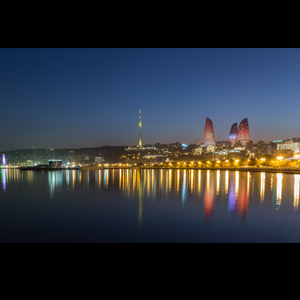
Baku, the capital of this Eurasian nation, is home to old-world palaces and modern skyscrapers, mud volcanoes, and Ateshgah, the Fire Temple, which is a place of worship for Hindus, Sikhs, and Zoroastrians. The Indian traveler will find in Baku much that is new and exciting, but also much that is familiar and comforting: Shah Rukh Khan fans and butter chicken being just a couple of examples.
Over the years, on my travels, whenever people learn I’m from India, the foremost reaction I get from tourist guides, chefs at local eateries, hotel staff, and shopkeepers is twinkle in their eyes and excitement in their voices as they ask, “Oh, you know Shah Rookh Khan?” To which, I always and inevitably smile, as though he’s a friend who I run with every morning or share my evening cuppa with! Of course, I diligently assure everyone that SRK would indeed love their country, their cuisine, and more.
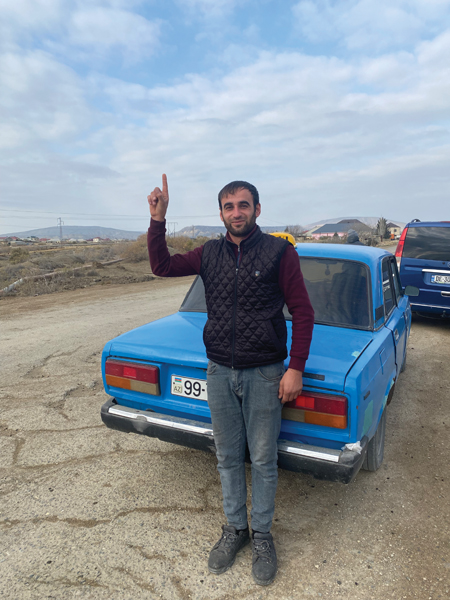
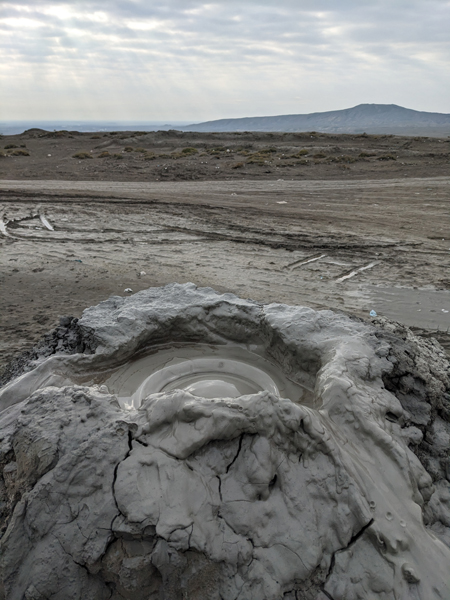
Samundar, the local taxi driver and an SRK fan, who drove us to the Mud Volcanoes .
It was the same this winter, when, in December, I landed in Baku, Azerbaijan, a transcontinental country located at the boundary of Eastern Europe and Western Asia.
Let me start with the Bollywood jukebox that was played for us on the way to the Mud Volcanoes in Gobustan Reserve, an hour’s drive from Baku. As soon as we got into the vehicle, Samundar, our taxi drivercum- tour guide, welcomed us with the biggest smile, having found out that we are from the land of Shah Rukh Khan. Before he hit the accelerator, he opened the YouTube app on his phone and searched for his mostloved song, “Tujhe dekha to” from the film, Dilwale Dulhania Le Jaayenge. We sang along while the rusty vehicle added to the charm of the landscape. Samundar, who had just become a father, emphasized how his name too came from an Indian word! A fan of all things Indian, his playlist, after SRK’s numbers, moved on to songs like “Jimmy, Jimmy,” “Awara Hoon,” et al.
Gobustan, a UNESCO World Heritage Site
Gobustan National Park, officially called Gobustan Rock Art Cultural Landscape, is a hilly and mountainous site occupying the southeast end of the Greater Caucasus Mountain ridge. It is an attraction for both scientists and tourists. In 1966, Gobustan was declared a national historical landmark of Azerbaijan in an attempt to preserve the ancient carvings, relics, mud volcanoes, and gas stones in the region. In 2007, it was declared a UNESCO World Heritage Site.
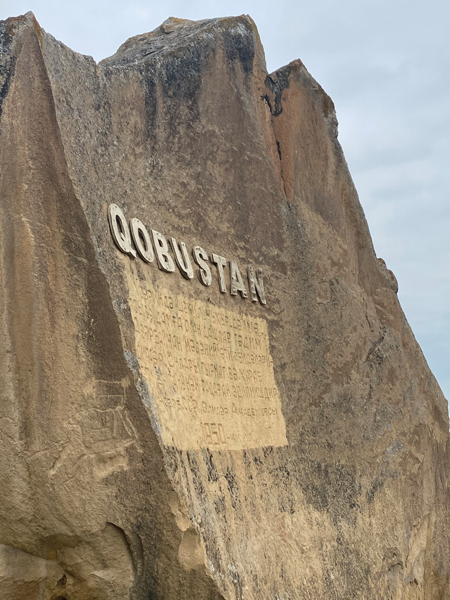
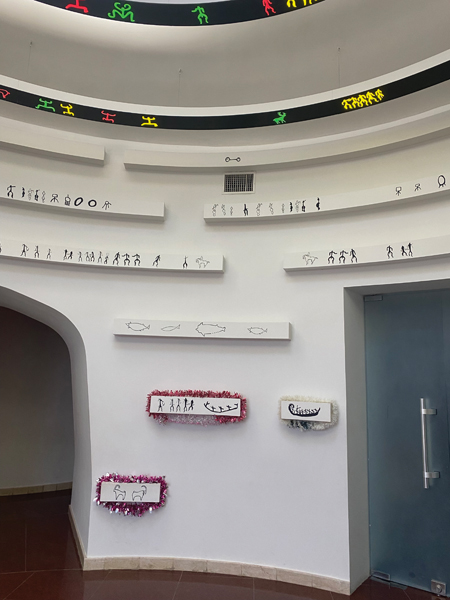
Gobustan National Park Museum. Here, one can learn about the history and the meaning of the petroglyphs, caves, and settlements dating as far back as 40,000 years.
When we reach the mud volcano, like a good tourist guide, Samundar was quick to light a matchstick and show us how the volcano flickered as we reached the spot. Not only was he a Bollywood buff, but he also turned out to be an ace photographer. He insisted we get a handful of pics clicked at the spot in the typical SRK pose (arms spread wide open!). He told us that when the weather permits, tourists bathe in the mud that is supposed to have medicinal qualities (Not that day, though: it was nine degrees).
For us, Samundar epitomized how the charm of Azerbaijan truly lies in the warmth of the locals. Even when they are not from the hospitality industry, they sure know how to show their country in the most pleasing way to outsiders. As you sit to dine at any of the eateries in Baku or walk through the streets admiring the works of street artists selling their works, you’d find it easy to make a conversation with the locals — as they enquire about the weather in your country, pay a compliment on how they love the way people in your country dress up, or insist you have an extra cup of tea or coffee and not charge you for it either.
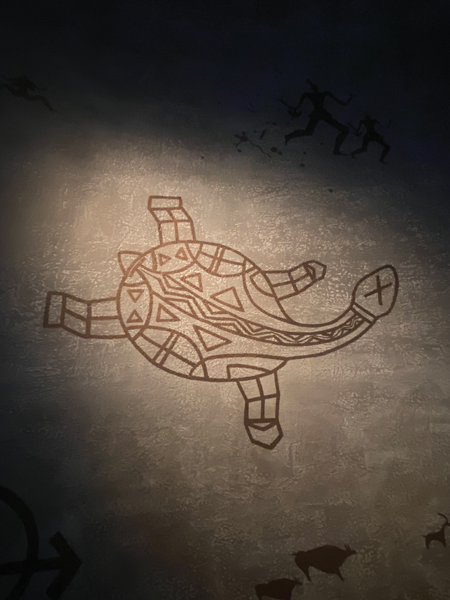
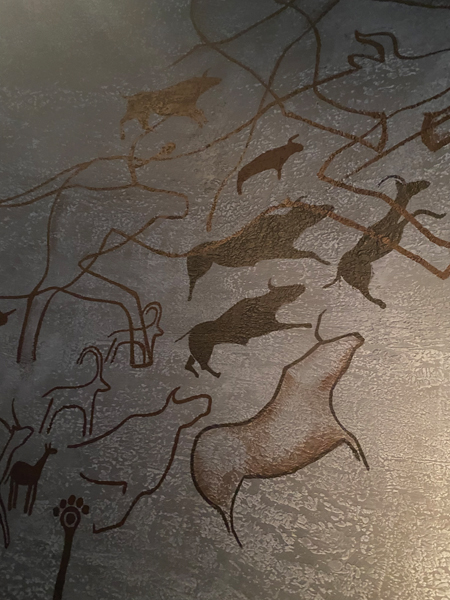 Petroglyphs—the images engraved into the rocks, caves, and settlements dating as far back as 40,000 years.
Petroglyphs—the images engraved into the rocks, caves, and settlements dating as far back as 40,000 years.
Mud volcanoes erupt naturally, but how they light up on fire is still debated among scientists. They are not really volcanoes at all but take their name from their resemblance to the molten lava—it’s safe to get closer. It’s methane and carbon dioxide gases released from deep within the Earth that caused Gobustan’s mud volcanoes to constantly bubble away and release a drizzle of wet mud. It’s estimated that 300 of the planet’s estimated 700 mud volcanoes are located in Gobustan, Azerbaijan, and the Caspian Sea.
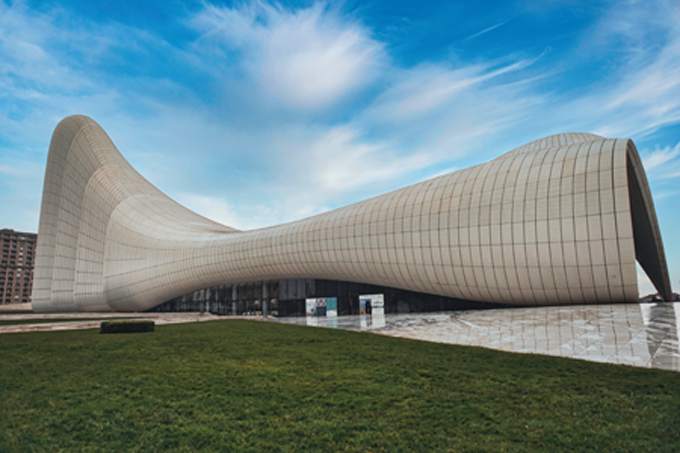 [Top] Heydar Aliyev Center with its striking architecture of fluid, sweeping curves.
[Top] Heydar Aliyev Center with its striking architecture of fluid, sweeping curves.
Before coming to the volcanoes, we had made a stopover at The Gobustan National Park Museum, an interactive, modern museum that explained the meanings of the carvings in the park outside. It’s here that you can take a moment to understand the history and meaning of the petroglyphs—the images engraved or drawn into the rocks, caves, and settlements dating as far back as 40,000 years.
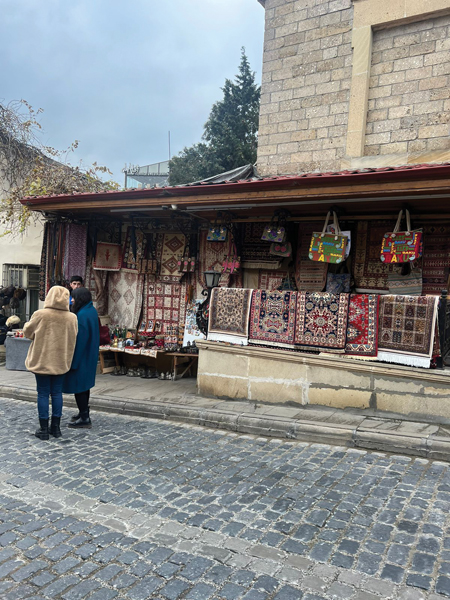
Stepping out from the museum, one can explore the landscape of stacked boulders, rock shards, and caves, and identify the petroglyphs. And yes, start by trying your hand at Gavaldash, the stone that produces music. Most likely, the ancient inhabitants used it as a musical instrument. The marks on the stones show that they were struck in places that protruded in some way into the air and could reverberate.
[Left] Icherisheher. Home to cobbled streets and palaces, it is the oldest inhabited part of Baku.
Baku, a blend of the ancient and the modernBaku, modern
We headed back to Baku and were mesmerized by its aesthetic blend of the modern and the old. A bustling contemporary city with European vibes, it provides a stimulating contrast to the history and nature that we had just left behind in Gobustan. At one point of the city, you’d be looking at the skyscrapers in steel and glass; and at the other, you’d be in awe of the minarets and domes which are typical of Azerbaijani architectural style.
I’d recommend not leaving the capital until you’ve spent half a day stopping at the Heydar Aliyev Center with its striking architecture of fluid, sweeping curves that carry the signature stamp of the late Zaha Hadid, a renowned architect. Baku Flame Towers, where the LED lights embedded in the exterior add charm at night, is another interesting stop. The Azerbaijan National Carpet Museum is home to centuries-old carpets and other textiles, and more. The Heydar Mosque, which was completed in 2014, is built in the ancient Azerbaijani architectural style.
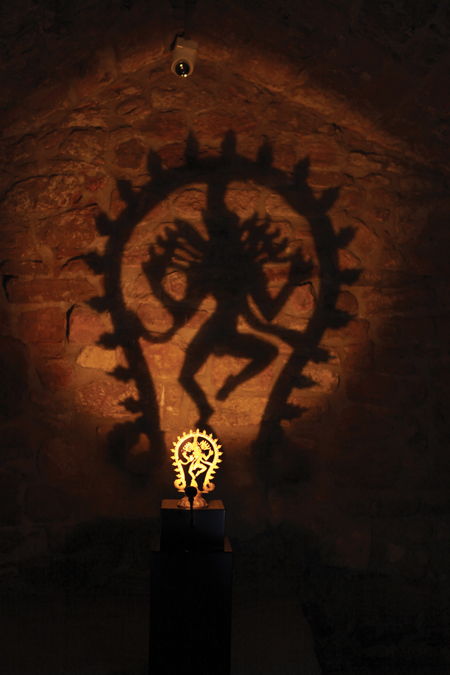
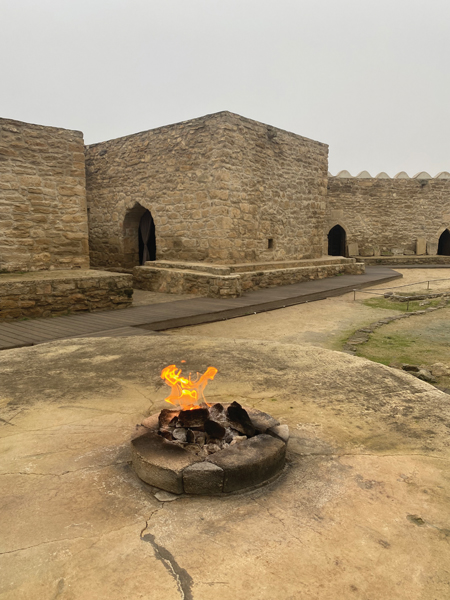
Ateshgah: The Temple of Fire. Nominated to the List of World Heritage Sites, UNESCO in 1998.
The House of Fire (Many call it the Indian Temple)
Ateshgah, also known as the Fire Temple of Baku, is where you’d spot Indian inscriptions alongside Persian and others. The temple was once a Hindu, Sikh, and Zoroastrian place of worship. Built during the 16th and 17th centuries, it was abandoned in the late 19th century as the Silk Road gradually lost its importance as a trade route and a new oil-gas industry took shape around the temple overwhelming the ancient place of worship. You’ll be amazed to see the “eternal flame.” Until the 19th century, natural gas leaked through the rock around the temple causing the “burning earth” phenomenon. But it went out after nearly a century of exploitation of petroleum and gas in the area and is now lit by gas piped from the nearby city. The temple ceased to be a place of worship after 1883 with the installation of petroleum plants at Surakhany and the complex was turned into a museum in 1975.
Figures of Ganesha and Nataraja, image stamps of Guru Nanak Dev, and more are part of the space. Though not much is known about the arrival of Hindu worshippers to the Temple, the inscriptions and other evidence suggest that the place was of particular importance for Indians worshiping Shiva and Ganesha. Interestingly enough, many Indians still visit this temple for blessings on special occasions. Every year, ancient fire rituals are commemorated during the celebration of the national holiday, Novruz.
From Ateshgah, take a detour to Yanardagh, the burning mountain where a natural gas fire blazes continuously on a hillside on the Absheron Peninsula around the Caspian Sea near Baku. Unlike mud volcanoes, this flame burns fairly steadily as it involves a steady seepage of gas from the subsurface. The 10-meter wall of fire is constantly burning at the foot of the hill. Since it burns irrespective of the weather conditions, the mountain is considered sacred. Natural fire inspired ancient people and played a crucial role in the creation of religious beliefs, such as Zoroastrianism, at the center of which was the cult of fire. Today, the place is protected, and extensive archaeological research is being conducted in this area.
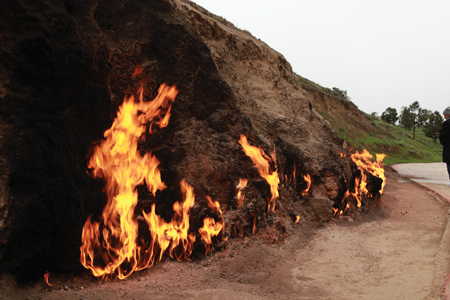
Even if you make a short trip to Baku, you’re likely to take with you, in addition to a box of pakhlavas—of course!— the sights of cobbled streets and palaces where the Palace of the Shirvanshahs a 15th-century palace built by the Shirvanshahs, has been described by UNESCO as one of the pearls of Azerbaijan’sz architecture at Icherisheher, the oldest inhabited part of Baku. Just a five-minute walk away is Nizami Street dotted with Indian eateries. These, along with the music of the locals playing on the streets and the welcoming vibe of the cats, suggest this is home!
Yanardag: The Burning Mountain. A natural gas fire that blazes continuously on a hillside on the Absheron Peninsula, Caspian Sea.
Purva Grover, a postgraduate in mass communication and literature, is an author, journalist, poet, playwright, and stage director. She’s also the host of the monthly column, “Monsoon of Memories,” in this magazine.
The gastronomic delights of Baku
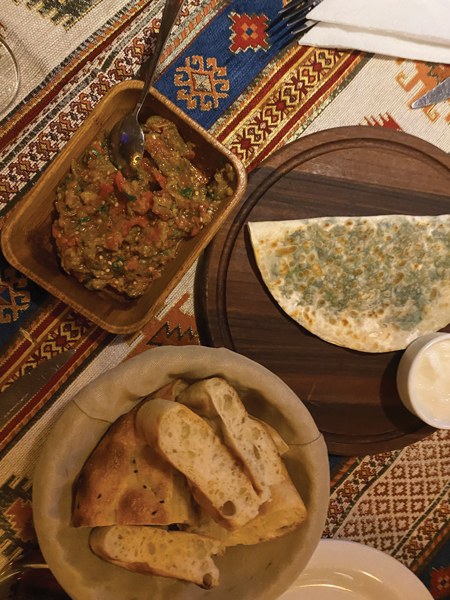
Mangal Salad: This eggplant-based salad, combined with other chopped, mixed, and barbecued vegetables, is likely to remind you of Baingan Bharta from India, Salatet Rahib from Lebanon, and Baba Ghanoush from the larger Levantine region.
Adjika: A herb condiment that is largely prepared with peppers and is served with breads and kebabs as a dip.
Gutab: The country’s flatbread that comes with the stuffing of your choice from greens to meat. Locals refer to it as their fast food and you can pick one, freshly prepared, from various shops, bakeries, or eateries. It is prepared on a large circular metal griddle called “saj.”
Pakhlava: Made from rice flour and filled with nuts, it’s their baklava. Also try the ones made in Shekhi with a generations-old recipe, especially the ones with walnuts.
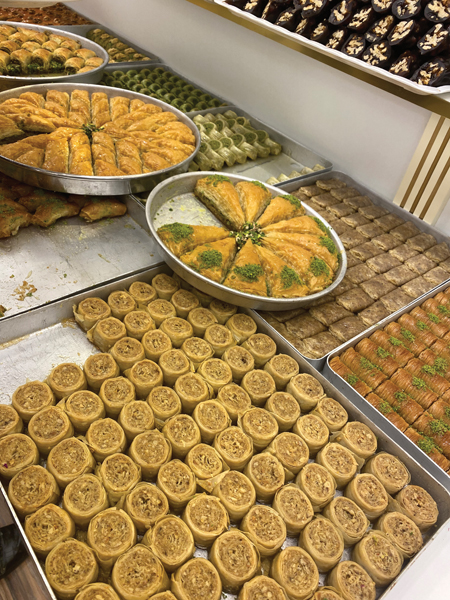
Kebabs: Take your pick of minced or chopped meat, fish, or chicken. Enjoy the deep, roasted flavor with lavash, the local bread.
Dushbara: Think momos and dumplings—only tastier and filled with minced meat and seasonings, cooked in broth.
Desi khana in Baku: If trying out a newer cuisine is not what you enjoy, then step into The Hindistan Metbexi, which translates as The Indian Kitchen, or savor the Little India vibe on Nizami Street. The aroma of tadka is likely to make you feel instantly at home. The countless eateries include—but are not limited to—Bombay Zaika, Shahi Darbar, Delhi Darbar, and more. A few of the eateries like Namaste have been around since 1998, a testament to how desi food is relished globally. Most of these eateries offer a mix of Indian (Hind) and Middle-Eastern (Arab) cuisines. Some even have exclusive biryani zones. We ate at Namak; and our hostess, Gul, knew rather well how Indians crave dal makhani!
Enjoyed reading Khabar magazine? Subscribe to Khabar and get a full digital copy of this Indian-American community magazine.
blog comments powered by Disqus










